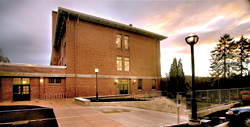In Bothell, tickets to Ben Vereen are selling like hotcakes. In Delridge, audiences are anticipating performances by Phffft! Dance Theatre. Comic Lauren Weedman is expected to appear on First Hill in June. And before long, tours of Broadway musicals may be coming to Bellevue.
Seems like every neighborhood in metro Seattle is celebrating or planning the opening of a new arts center or theater. This is great news for patrons who no longer have to drive downtown to go to a show, and for small theater, dance, and music troupes who need affordable rental space. But is more always better? Some observers express concern that the arts community’s emphasis on funding capital projects drains dollars from artists and arts companies. And others complain of a more insidious danger: the fragmentation and dilution of the arts community. Could the Seattle arts scene become the equivalent of cable TV? Hundreds of channels and not much on?
Undeniably, the region’s new arts centers have a role to play, especially in underserved neighborhoods. Bothell’s Northshore Performing Arts Center has been hopping with school music ensembles and troupes such as the Woodinville Rep and Attic Theatre since it opened in November. The Youngstown Cultural Arts Center promises to revitalize a hardscrabble corner of Seattle with performances, art classes, a recording studio, and more. Seattle University’s Lee Center for the Arts will help train student artists and provide a secure home for the once- endangered Empty Space Theatre. And the Performing Arts Center Eastside (PACE) will give the burgeoning suburbs a venue on the scale of McCaw or Benaroya halls.
Most will host a combination of touring shows and community groups. For the latter, at least, there is a clear and demonstrated need. “There’s a huge demand from school groups and local groups for a real theater that is not a gymnasium,” says Northshore’s director of communications and marketing, Nikki Neuen. The new facility has 600 seats, and “our feasibility studies showed that this area could support a theater twice this size.” Directors of theaters already operating in the International District, South Lake Union, Capitol Hill, and elsewhere agree that local residents are hungry for more spaces to practice and partake in art.
But add up the cost of these four projects: Northshore, $8.5 million; Youngstown, $12 million; the Lee Center, $6.75 million; PACE, a cool $100 million. That $127 million would buy a lot of paintbrushes and pointe shoes.
PACE Executive Director Richard Collins argues that “when you’re doing a capital campaign, you’re not taking money away from small groups. You’re tending to open up new sources of funding.” Many donors who do not characteristically give to arts groups are willing to invest in a building, he says, because “it’s permanent. It does not come and go.” Also, he emphasizes that buildings support artists directly. Intiman Theatre “started in a closet in Kirkland,” he says, and didn’t start to grow until it secured an adequate, permanent space at Seattle Center. “We’re not building for the sake of building, we’re building for the arts, the artists, and audiences.”
Finally, one has to wonder what the increasing decentralization of arts activity means for the civic life of Seattle. Says Jacqueline Moscou, artistic director of Langston Hughes Performing Arts Center in the Central District: “Seattle is a mirror of what is going on nationally. Many groups are trying to go it alone. We are becoming divided, when arts organizations are supposed to be there to bring together and bridge communities.”
The answer, some say, is not to build less but to build thoughtfully—the way the Lee Center adjusted plans to embrace Empty Space, for instance. Administrators from Moscou to Capitol Hill Arts Center artistic director Matthew Kwatinetz to Consolidated Works’ Corey Pearlstein call on arts groups to fight isolationism. Pearlstein says, “I believe highly in collaboration; there shouldn’t be a competitive landscape in the arts.” ConWorks already practices what Pearlstein preaches, and you can bet more partnerships are on the way there. The center unveiled a new music space and several new galleries late last week.
Gala opening of the Northshore Performing Arts Center is 7 p.m. Sun., Feb. 26; 425-489-6018, www.npacf.org. Youngstown Cultural Arts Center opens 6–10 p.m. Fri., Feb. 24; 206-935-2999, youngstownarts.org. For info on PACE: 425-462-4295, www.pac-eastside.org. The Lee Center: www.seattleu.edu/artsci/finearts.




